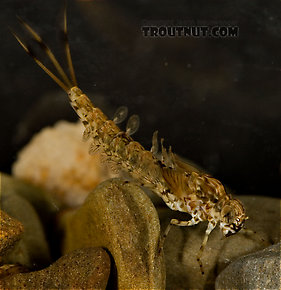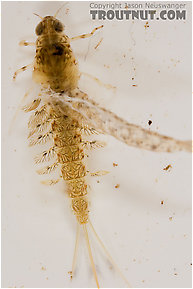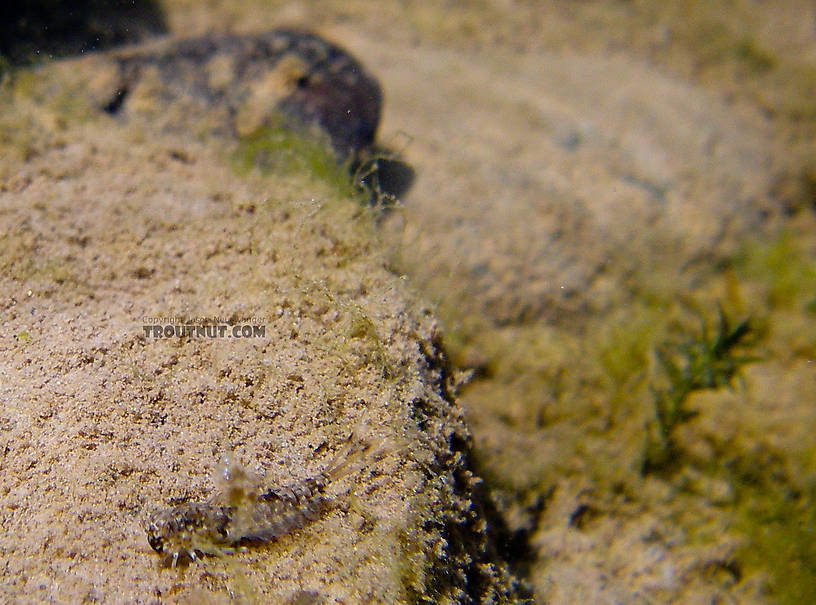Blog & Latest Updates
Fly Fishing Articles
Insects by Common Name


Mayfly Genus Siphlonurus (Gray Drakes)
Taxonomic Navigation -?-
Kingdom
Animalia (Animals)
» Phylum
Arthropoda (Arthropods)
» Class
Insecta (Insects)
» Order
Ephemeroptera (Mayflies)
» Family
Siphlonuridae (Gray Drakes)
» Genus Siphlonurus (Gray Drakes)
12 species aren't included.
Common Names
| Match | Common Name |
| Gray Drakes | |
| Black Drakes |
The main Western species, Siphlonurus occidentalis, is much more valuable. Its importance in the West is often compared to that of Isonychia in the East.
Where & When
Preferred Waters: Slow, alkaline (Alkaline: Having a pH higher than 7 (opposite of acidic). Moderately alkaline water is ideal for trout because it's better for the growth of phytoplankton, the usual base of the aquatic food chain, and that's good for the growth of everything higher up the chain, including trout.) streams and lakes
Siphlonurus hatches are generally slow-paced events, and it takes two to three months for the entire generation to hatch out of a given stretch of water. See the species pages for emergence details about each one.Hatching Behavior
Time Of Day (?): Morning through midday
Habitat: Slow, shallow water
Water Temperature: Varies, but 60-63°F is ideal
There is some disagreement about exactly how Siphlonurus duns hatch. It is certain that they crawl out onto shore sometimes and hatch on the surface at other times, but which of these behaviors is more prominent is anybody's guess. Habitat: Slow, shallow water
Water Temperature: Varies, but 60-63°F is ideal
The time of emergence is also up in the air; most say it is in the morning, but there are reports of emergence in the afternoon and in the middle of the night, as well. One account suggests it is most common in the evening.
Authors generally agree that, regardless of hatching mode or time, the duns are the least important stage of this species. There are reports of trout feeding well on them, and this is sometimes attributed to the wind blowing the duns into the water.
In Mayflies Ted Fauceglia relays a detailed account by Dick Stewart of the hatching of Siphlonurus duns, quoted here in part:
They then emerge by swimming toward the surface and immediately taking flight. They pop through the surface film like miniature helicopters rising toward the open sky. We believe that molting takes place either very quickly or when the duns are high in the trees, for try as we might, we almost never can find a dun (day or night) despite the fact that we can locate hundreds of spinners.
Another point on which most agree is that Siphlonurus duns emerge from very shallow margins and backwaters, sometimes far from the trout in the main channel.
Spinner Behavior
Time Of Day: Usually dusk in the East and Midwest, morning in the West, sometimes afternoon in cold weather
Gray drakes return as spinners two to four days after hatching as duns, and they gather in swarms over the riffles. Accounts of their ovipositing behavior vary: some say the females repeatedly dive and dip their abdomens briefly into the water, while others say they drop their eggs from the air. Both genders eventually fall spent (Spent: The wing position of many aquatic insects when they fall on the water after mating. The wings of both sides lay flat on the water. The word may be used to describe insects with their wings in that position, as well as the position itself.), but the spinner falls may be tricky to locate because the females sometimes fly far upstream after mating but before ovipositing. Trout may feed on Siphlonurus spinners very selectively.Nymph Biology
Current Speed: Slow
Substrate: Silt, vegetation
Siphlonurus nymphs are not completely intolerant of medium to fast current, but their best populations are found in slow streams or still waters, often with plenty of weed growth. They are more frequently important to fly fishers than the duns.Substrate: Silt, vegetation
They are extremely adept swimmers.
Pictures of 22 Mayfly Specimens in the Genus Siphlonurus:
Siphlonurus quebecensis (Gray Drake) Mayfly Nymph View 9 Pictures
View 9 Pictures
 View 9 Pictures
View 9 PicturesCollected May 13, 2007 from the Delaware River in New York
Added to Troutnut.com by Troutnut on May 18, 2007
Added to Troutnut.com by Troutnut on May 18, 2007
Male Siphlonurus quebecensis (Gray Drake) Mayfly Spinner View 10 Pictures
View 10 Pictures
 View 10 Pictures
View 10 PicturesCollected June 2, 2005 from the Namekagon River in Wisconsin
Added to Troutnut.com by Troutnut on May 24, 2006
Added to Troutnut.com by Troutnut on May 24, 2006
Siphlonurus quebecensis (Gray Drake) Mayfly Nymph View 5 PicturesI photographed this nymph in the middle of molting between one instar (Instar: Many invertebrates molt through dozens of progressively larger and better-developed stages as they grow. Each of these stages is known as an instar. Hard-bodied nymphs typically molt through more instars than soft-bodied larvae.) and the next (not hatching).
View 5 PicturesI photographed this nymph in the middle of molting between one instar (Instar: Many invertebrates molt through dozens of progressively larger and better-developed stages as they grow. Each of these stages is known as an instar. Hard-bodied nymphs typically molt through more instars than soft-bodied larvae.) and the next (not hatching).
 View 5 PicturesI photographed this nymph in the middle of molting between one instar (Instar: Many invertebrates molt through dozens of progressively larger and better-developed stages as they grow. Each of these stages is known as an instar. Hard-bodied nymphs typically molt through more instars than soft-bodied larvae.) and the next (not hatching).
View 5 PicturesI photographed this nymph in the middle of molting between one instar (Instar: Many invertebrates molt through dozens of progressively larger and better-developed stages as they grow. Each of these stages is known as an instar. Hard-bodied nymphs typically molt through more instars than soft-bodied larvae.) and the next (not hatching).Collected May 13, 2007 from the Delaware River in New York
Added to Troutnut.com by Troutnut on May 18, 2007
Added to Troutnut.com by Troutnut on May 18, 2007
3 Underwater Pictures of Siphlonurus Mayflies:


Several fast-swimming Siphlonurus nymphs blend in very well with the silt in this slow backwater along a trout stream.
In this picture: Mayfly Genus Siphlonurus (Gray Drakes).
In this picture: Mayfly Genus Siphlonurus (Gray Drakes).
StateWisconsin
LocationNamekagon River
Date TakenMay 15, 2004
Date AddedJan 25, 2006
AuthorTroutnut
CameraOlympus C740UZ

StateWisconsin
LocationNamekagon River
Date TakenMay 15, 2004
Date AddedJan 25, 2006
AuthorTroutnut
CameraOlympus C740UZ
Your Thoughts On Siphlonurus:
Top 10 Fly Hatches
Top Gift Shop Designs
Eat mayflies.
Top Insect Specimens
Miscellaneous Sites
Troutnut.com is copyright © 2004-2024 Jason
Neuswanger (email Jason). See my FAQ for information about use of my images.
 privacy policy
privacy policy
